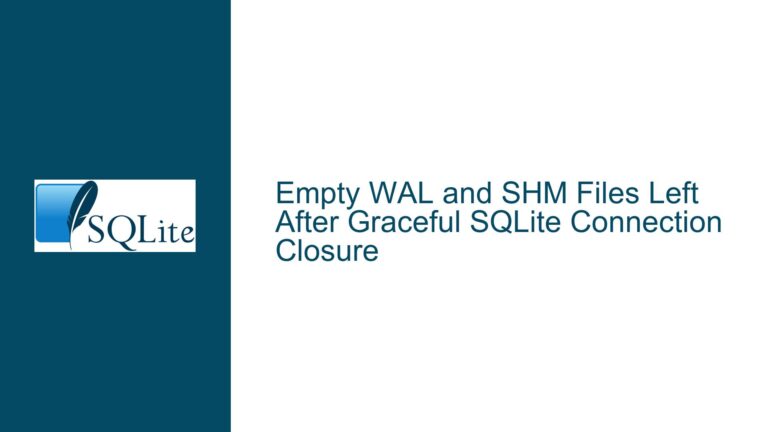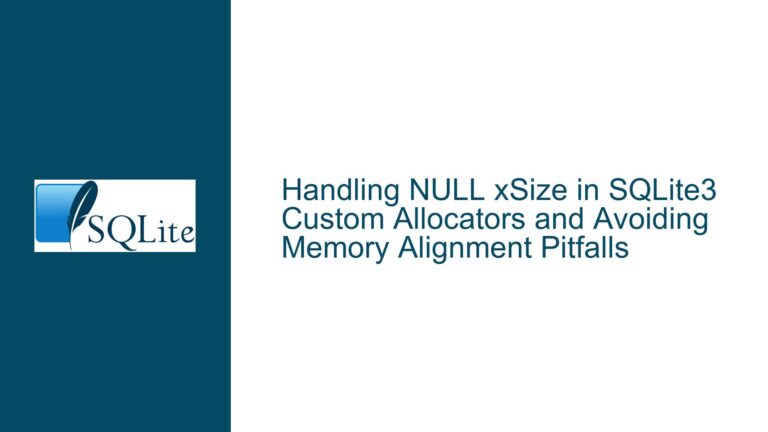Security Risks and Configuration Management in SQLite CLI’s Local .sqliterc Proposal
Understanding the Local .sqliterc Configuration Proposal and Its Implications
The SQLite command-line interface (CLI) provides a mechanism for users to define persistent configuration settings through initialization files. By default, the SQLite CLI reads a .sqliterc file from the user’s home directory (~/.sqliterc) or paths specified by the XDG Base Directory Specification. A recent proposal suggested enhancing this behavior by allowing the SQLite CLI to automatically discover and load a .sqliterc file located in the current working directory. This feature would enable teams collaborating on a codebase to enforce consistent configuration settings—such as enabling foreign key constraints, setting output modes, or registering extensions—without requiring manual intervention from each developer.
The rationale for this proposal parallels patterns seen in developer tooling ecosystems. Tools like npm, Bazel, and Git support project-specific configuration files (.npmrc, .bazelrc, .gitattributes) to ensure uniformity across team environments. For example, a .sqliterc in a project directory could enforce PRAGMA foreign_keys = ON; for all developers, eliminating inconsistencies caused by differing local configurations. However, this proposal was met with concerns regarding security risks, configuration precedence conflicts, and philosophical alignment with the Unix tooling paradigm.
Critics of the proposal highlighted that automatically loading a configuration file from the current working directory introduces a security vulnerability. If a user executes the SQLite CLI within an untrusted directory—such as when analyzing data from unknown sources—a malicious .sqliterc file could execute arbitrary SQL commands or load unsafe extensions. Additionally, existing configuration precedence rules (user-specific settings overriding system-wide settings) could conflict with project-specific configurations, leading to unintended behavior. The SQLite maintainers emphasized the importance of maintaining the CLI’s simplicity and composability, advocating for wrapper scripts that explicitly handle configuration loading instead of embedding complex logic into the CLI itself.
Security Vulnerabilities and Configuration Precedence Conflicts
The primary objection to automatically loading a local .sqliterc file stems from security risks inherent in trusting the current working directory. The SQLite CLI’s ability to execute arbitrary SQL statements and load extensions makes it a potential vector for code injection attacks. For instance, a malicious actor could place a .sqliterc file in a directory containing seemingly benign data. When a user launches the SQLite CLI to inspect a database in that directory, the rogue .sqliterc could execute commands like .load /path/to/malicious_extension or ATTACH DATABASE 'critical_system.db' AS target; PRAGMA target.wal_checkpoint=FULL;, potentially leading to data corruption or exfiltration. This risk is particularly acute in environments where users frequently interact with untrusted directories, such as data analysis pipelines or shared hosting systems.
A secondary concern involves configuration precedence. The SQLite CLI’s existing initialization logic follows a hierarchy: system-wide configurations (if supported), followed by user-specific configurations (~/.sqliterc or XDG-compliant paths), and finally command-line arguments. Introducing a local .sqliterc would add another layer to this hierarchy, creating ambiguity about which settings take precedence. Should the local configuration override the user’s personal settings, or vice versa? For example, if a developer’s ~/.sqliterc sets .mode box for human-readable output, but the project’s .sqliterc specifies .mode csv for machine-parsable output, conflicting preferences could disrupt workflows. Resolving such conflicts would require explicit rules, complicating the CLI’s behavior and documentation.
Philosophical considerations also play a role. The SQLite CLI adheres to the Unix principle of doing one thing well: it focuses on executing SQL statements and interacting with databases, delegating ancillary tasks like configuration management to external tools. This design allows users to compose functionality through shell scripts, environment variables, or wrapper utilities. Forcing the CLI to handle directory-specific configurations would dilute its core mission and increase maintenance overhead. Moreover, many general-purpose CLI tools avoid current-directory configuration files to maintain predictable behavior across diverse environments. Project-specific tools (e.g., npm, bazel) adopt such patterns because they operate within a controlled context, whereas SQLite’s CLI serves a broader, more varied audience.
Mitigating Security Risks and Implementing Project-Specific Configurations
To address the need for project-specific configurations without compromising security or simplicity, users can adopt several strategies:
1. Wrapper Scripts for Explicit Configuration Loading
A wrapper script can emulate the proposed local .sqliterc behavior by dynamically injecting the -init option when launching the SQLite CLI. For example, a Bash script named sqlite3-wrapper could check for the presence of a .sqliterc file in the current directory and pass it to the CLI:
#!/bin/bash
SQLITERC_PATH=".sqliterc"
ARGS=()
# Check for local .sqliterc and add -init if found
if [ -f "$SQLITERC_PATH" ]; then
ARGS+=("-init" "$SQLITERC_PATH")
fi
# Pass all command-line arguments to the SQLite CLI
exec /usr/bin/sqlite3 "${ARGS[@]}" "$@"
This approach provides the benefits of local configurations while keeping the SQLite CLI unchanged. Teams can commit the wrapper script to their repository, ensuring all members use the same initialization logic. Advanced scripts could merge multiple configuration files or allow environment variables to override settings.
2. Manual Configuration with Explicit -init Invocation
Users can manually specify a project’s .sqliterc file using the -init command-line option:
sqlite3 -init .sqliterc database.db
While less automated, this method eliminates ambiguity about which configuration is active and avoids security risks from implicit file loading. Teams can document this practice in their onboarding guides or integrate it into IDE launch configurations.
3. Securing the SQLite CLI in Untrusted Directories
To mitigate risks when working in untrusted directories, users should:
- Avoid running the SQLite CLI directly in directories obtained from untrusted sources.
- Use the
-noinitflag to disable automatic loading of initialization files:sqlite3 -noinit database.db - Audit
.sqlitercfiles for suspicious commands before execution, especially those loading extensions or modifying schemas.
4. Leveraging Environment Variables for Cross-Platform Configuration
Environment variables can supplement or replace initialization files for certain settings. For example, a SQLITE_INIT variable could store frequently used PRAGMA statements:
export SQLITE_INIT="PRAGMA foreign_keys = ON; PRAGMA journal_mode = WAL;"
sqlite3 -cmd "$SQLITE_INIT" database.db
This method avoids file-based configuration entirely, reducing exposure to malicious files but requiring users to manage variables across shells or terminals.
5. Version-Controlled Configuration with Extension Hooks
Projects requiring complex initialization logic can version-control a .sqlite_init.sql file and use the .read directive in a global or user-specific .sqliterc:
-- ~/.sqliterc
.read ./.sqlite_init.sql
This delegates configuration management to the project while maintaining explicit control over when and how the file is loaded. Developers must manually run .read .sqlite_init.sql if they prefer not to modify their personal .sqliterc.
By combining these strategies, teams can achieve the desired consistency and security without requiring changes to the SQLite CLI itself. The wrapper script approach strikes a balance between automation and safety, aligning with the Unix philosophy of composable tools while addressing the original proposal’s objectives.






